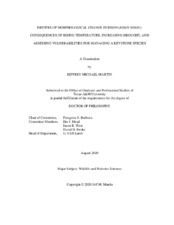| dc.description.abstract | Body size of animals is plastic and dependent on environmental conditions that are changing globally. In this dissertation, I explore environmental traits as they relate to and drive body size change of North American bison (Bison bison) along the Great Plains. I examined 1) 40,000 years of body size change in the fossil record, 2) five decades of long-term ecological dataset of body size change at one location and one decade of body size differences among 19 locations along the Great Plains, 3) seasonal heat flux and growth rates of bison along the Great Plains, and 4) bison managers’ vulnerabilities to environmental change. In the fossil record, I estimated body mass from a foot bone, the calcaneum, in 849 specimens that range over the 40,000 years and related that body and bone size to global temperature—reconstructed from the Greenland ice sheet. The rate of mass loss was 41 ± 10 kg per 1°C increase of global temperature. In the decadal dataset, I estimated asymptotic body mass of 19 herds from 6,400 observations of individual bison to relate body mass to average temperature and drought over the last five decades. Drought decreased asymptotic mass by ˗16 kg whereas temperature decreased mass between -1 and ˗115 kg, depending on location. I measured the seasonal effect of ambient heat load on growth of 700 Bison from 19 herds along the Great Plains from Saskatchewan (52 °N) to Texas (30 °N). Bison are better able to grow over summer when environmental heat loads are low. As seasons become warmer, reduction of body mass will likely alter reproduction to reduce annual growth of herds, the production of breed stock, and meat in the bison industry. I surveyed 132 bison managers from North America that represent private, public, and NGO sectors to measure their perceptions, practices, attitudes, and values related to environmental change. I found that private and public/NGO sectors differed in adaptive capacity and thus the score for vulnerability. The private sector was less vulnerable than the public/NGO sector because the private sector had greater access to information exchange, external revenue, and grazing leases. | en |


